CQUniversity Auditing and Ethics Report: Goodman Group Analysis
VerifiedAdded on 2022/08/29
|14
|2834
|19
Report
AI Summary
This report provides a comprehensive analysis of auditing and ethics principles, focusing on the audit of Goodman Group. The report begins by examining materiality, including its calculation and significance in identifying material misstatements in financial reports, as per ASA 32. It then delves into preliminary analytical review, analyzing key balance sheet and profitability ratios to identify areas of potential risk, such as profit margin fluctuations and changes in liquidity ratios. The report further assesses the cash flow statement, evaluating Goodman Group's going concern risk and the auditor's responsibilities in this context. The analysis includes an examination of cash inflows and outflows, non-cash transactions, and the auditor's assessment of the company's ability to continue as a going concern. The report concludes by discussing the auditor's opinion on the financial statements and highlights key audit matters.
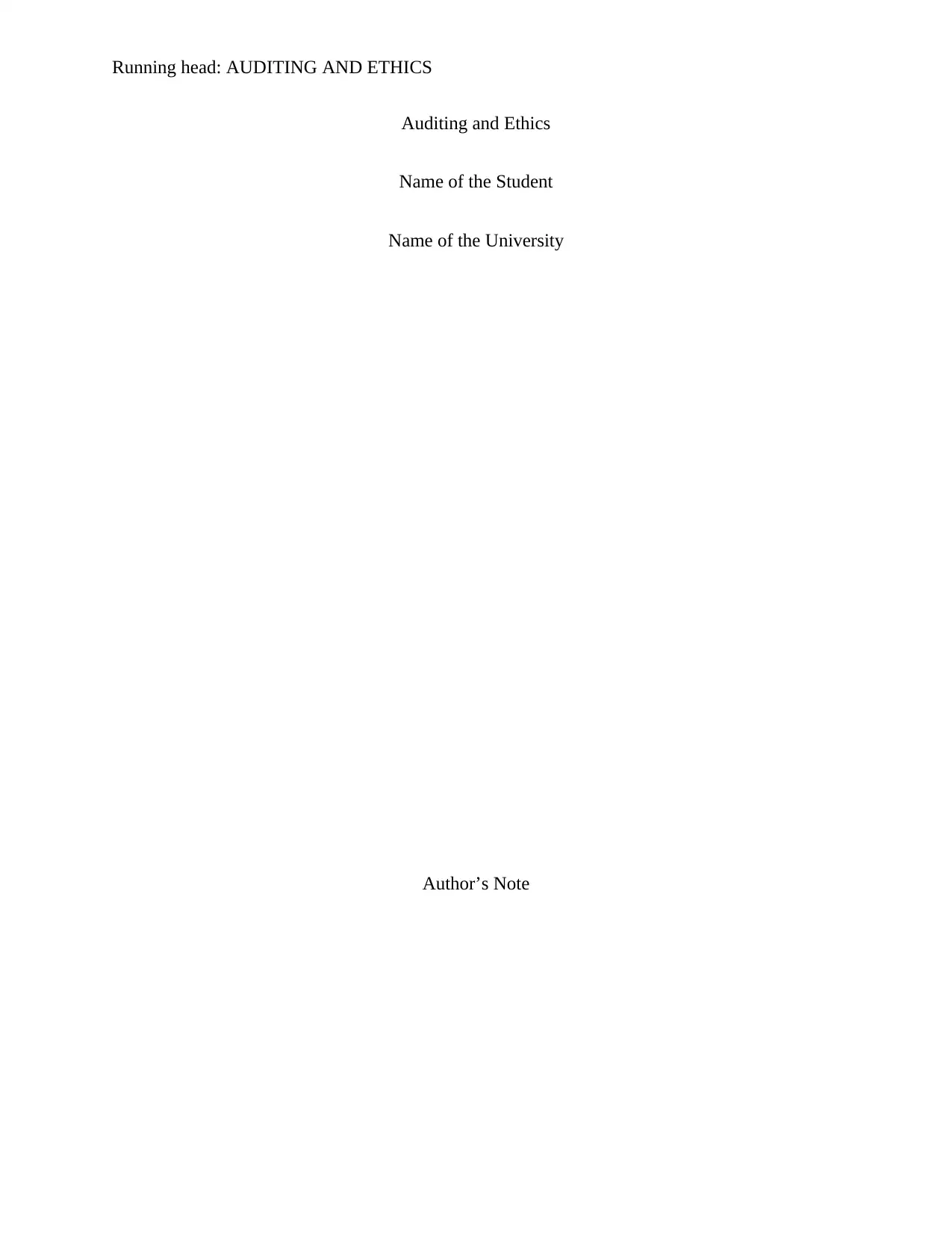
Running head: AUDITING AND ETHICS
Auditing and Ethics
Name of the Student
Name of the University
Author’s Note
Auditing and Ethics
Name of the Student
Name of the University
Author’s Note
Paraphrase This Document
Need a fresh take? Get an instant paraphrase of this document with our AI Paraphraser
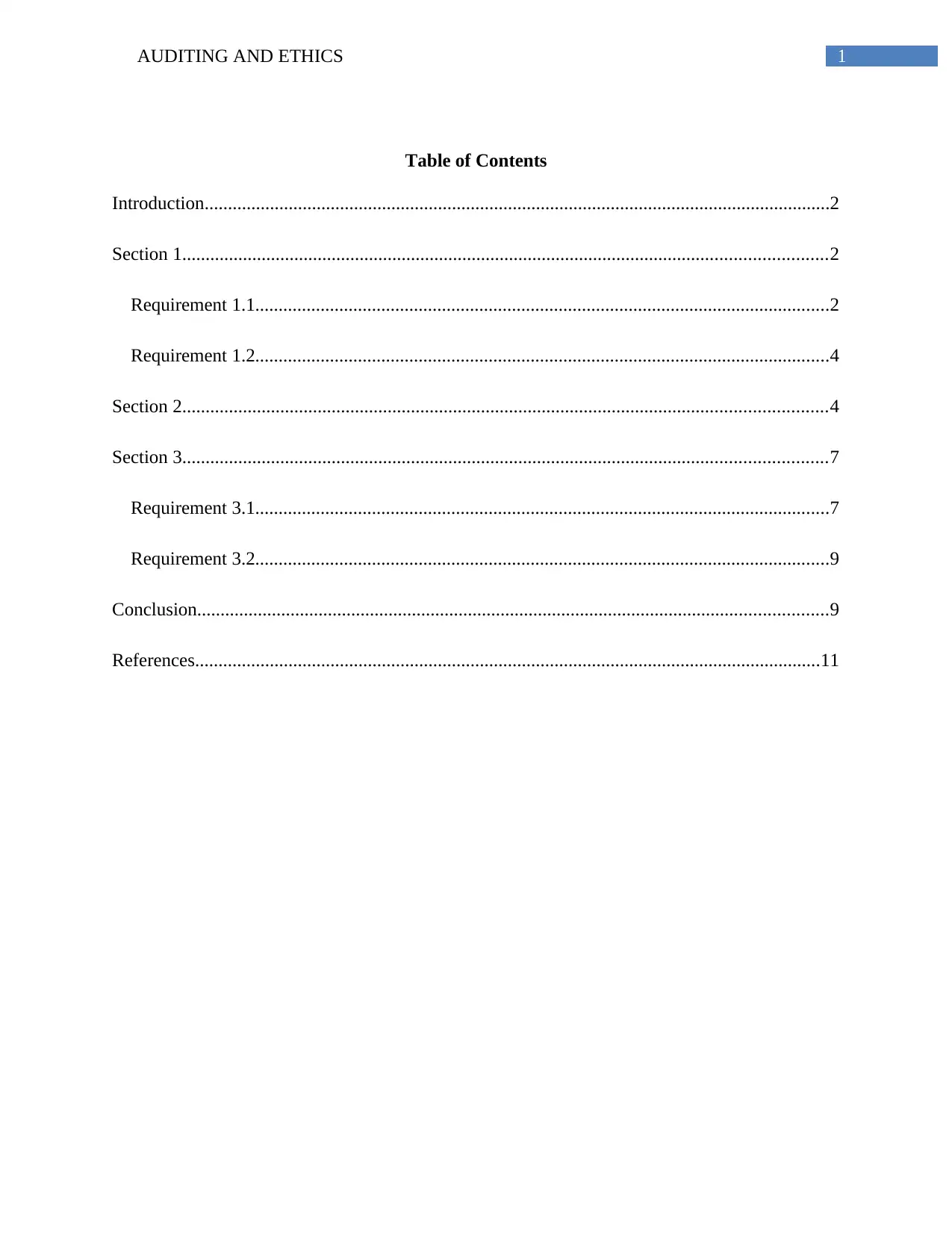
1AUDITING AND ETHICS
Table of Contents
Introduction......................................................................................................................................2
Section 1..........................................................................................................................................2
Requirement 1.1...........................................................................................................................2
Requirement 1.2...........................................................................................................................4
Section 2..........................................................................................................................................4
Section 3..........................................................................................................................................7
Requirement 3.1...........................................................................................................................7
Requirement 3.2...........................................................................................................................9
Conclusion.......................................................................................................................................9
References......................................................................................................................................11
Table of Contents
Introduction......................................................................................................................................2
Section 1..........................................................................................................................................2
Requirement 1.1...........................................................................................................................2
Requirement 1.2...........................................................................................................................4
Section 2..........................................................................................................................................4
Section 3..........................................................................................................................................7
Requirement 3.1...........................................................................................................................7
Requirement 3.2...........................................................................................................................9
Conclusion.......................................................................................................................................9
References......................................................................................................................................11
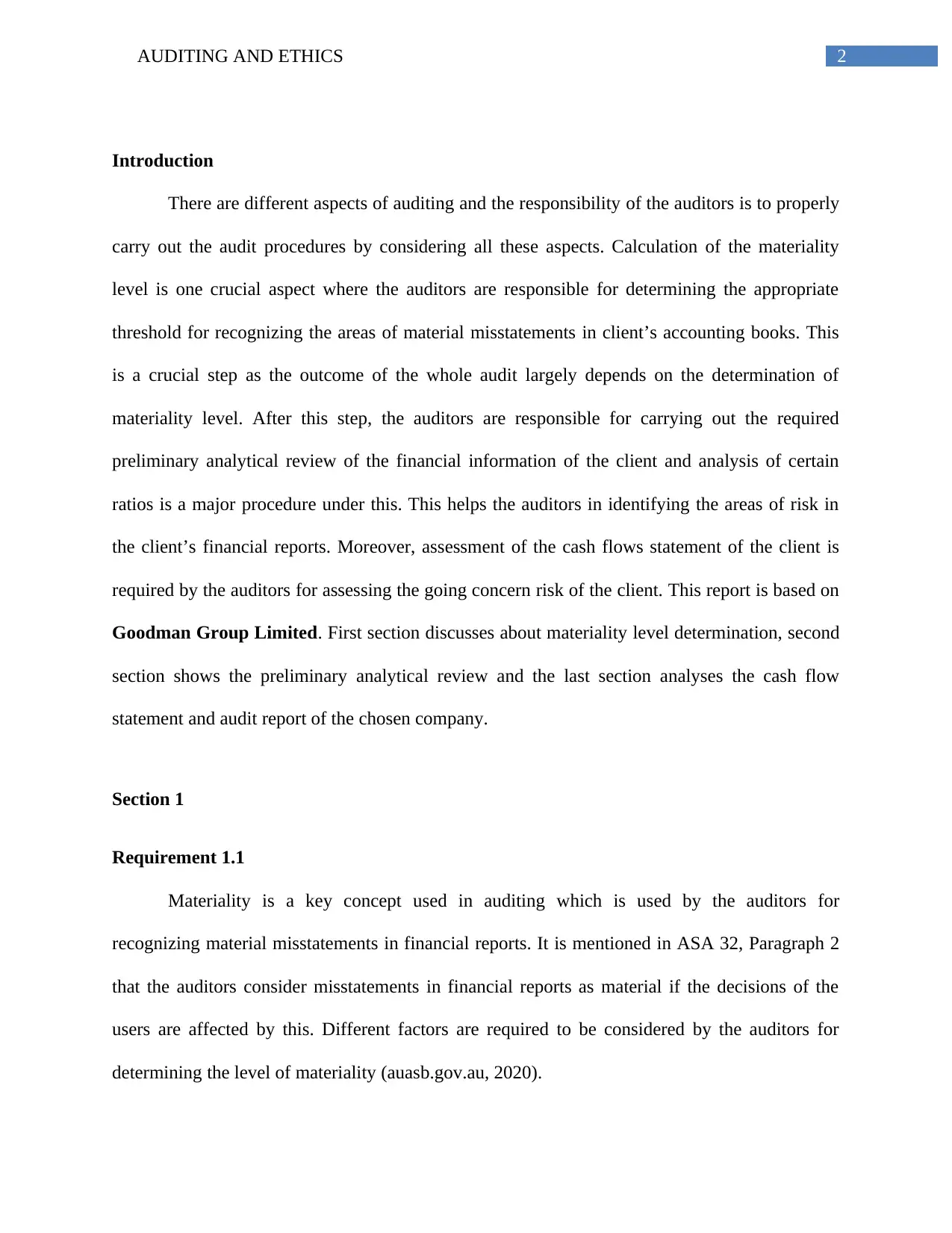
2AUDITING AND ETHICS
Introduction
There are different aspects of auditing and the responsibility of the auditors is to properly
carry out the audit procedures by considering all these aspects. Calculation of the materiality
level is one crucial aspect where the auditors are responsible for determining the appropriate
threshold for recognizing the areas of material misstatements in client’s accounting books. This
is a crucial step as the outcome of the whole audit largely depends on the determination of
materiality level. After this step, the auditors are responsible for carrying out the required
preliminary analytical review of the financial information of the client and analysis of certain
ratios is a major procedure under this. This helps the auditors in identifying the areas of risk in
the client’s financial reports. Moreover, assessment of the cash flows statement of the client is
required by the auditors for assessing the going concern risk of the client. This report is based on
Goodman Group Limited. First section discusses about materiality level determination, second
section shows the preliminary analytical review and the last section analyses the cash flow
statement and audit report of the chosen company.
Section 1
Requirement 1.1
Materiality is a key concept used in auditing which is used by the auditors for
recognizing material misstatements in financial reports. It is mentioned in ASA 32, Paragraph 2
that the auditors consider misstatements in financial reports as material if the decisions of the
users are affected by this. Different factors are required to be considered by the auditors for
determining the level of materiality (auasb.gov.au, 2020).
Introduction
There are different aspects of auditing and the responsibility of the auditors is to properly
carry out the audit procedures by considering all these aspects. Calculation of the materiality
level is one crucial aspect where the auditors are responsible for determining the appropriate
threshold for recognizing the areas of material misstatements in client’s accounting books. This
is a crucial step as the outcome of the whole audit largely depends on the determination of
materiality level. After this step, the auditors are responsible for carrying out the required
preliminary analytical review of the financial information of the client and analysis of certain
ratios is a major procedure under this. This helps the auditors in identifying the areas of risk in
the client’s financial reports. Moreover, assessment of the cash flows statement of the client is
required by the auditors for assessing the going concern risk of the client. This report is based on
Goodman Group Limited. First section discusses about materiality level determination, second
section shows the preliminary analytical review and the last section analyses the cash flow
statement and audit report of the chosen company.
Section 1
Requirement 1.1
Materiality is a key concept used in auditing which is used by the auditors for
recognizing material misstatements in financial reports. It is mentioned in ASA 32, Paragraph 2
that the auditors consider misstatements in financial reports as material if the decisions of the
users are affected by this. Different factors are required to be considered by the auditors for
determining the level of materiality (auasb.gov.au, 2020).
⊘ This is a preview!⊘
Do you want full access?
Subscribe today to unlock all pages.

Trusted by 1+ million students worldwide
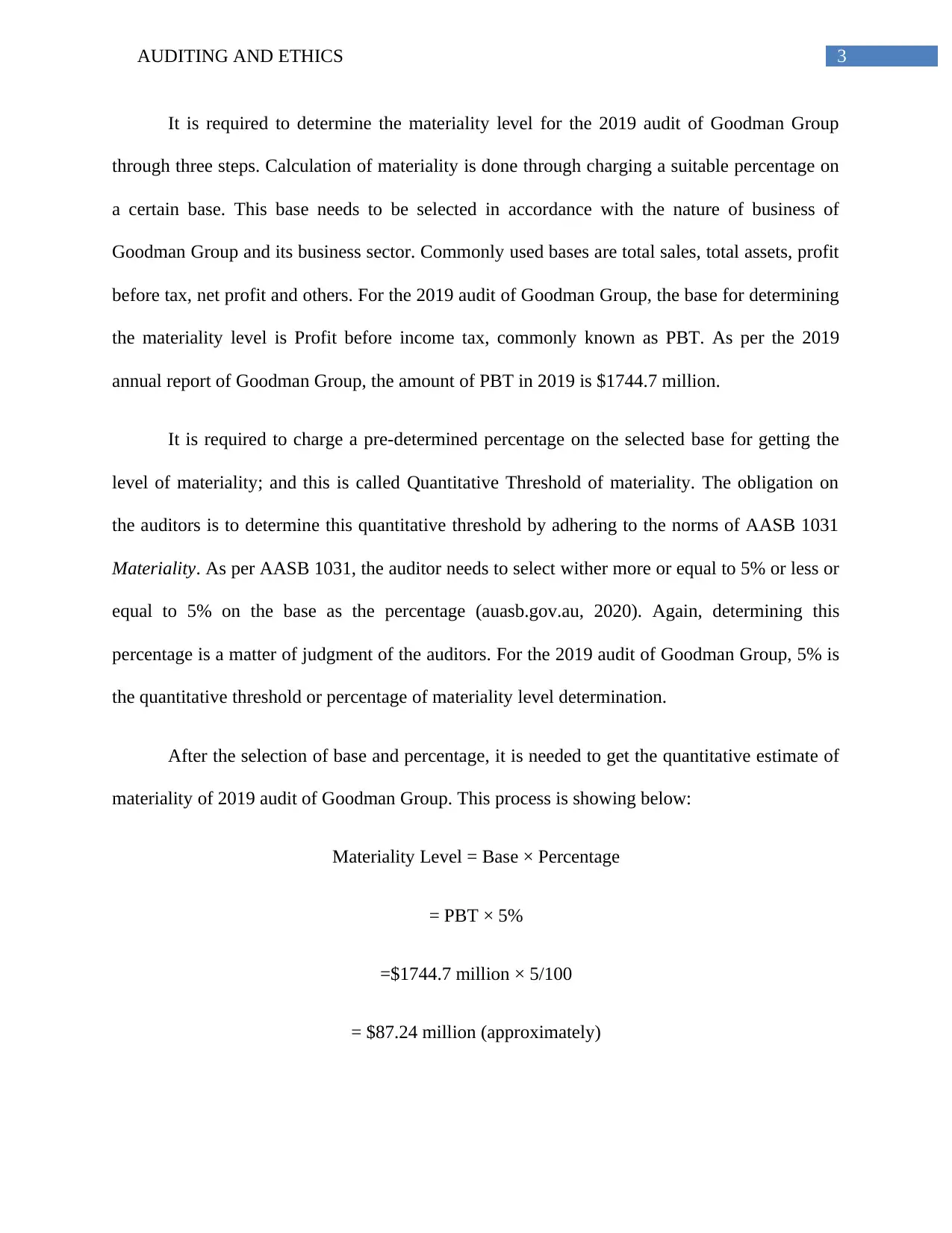
3AUDITING AND ETHICS
It is required to determine the materiality level for the 2019 audit of Goodman Group
through three steps. Calculation of materiality is done through charging a suitable percentage on
a certain base. This base needs to be selected in accordance with the nature of business of
Goodman Group and its business sector. Commonly used bases are total sales, total assets, profit
before tax, net profit and others. For the 2019 audit of Goodman Group, the base for determining
the materiality level is Profit before income tax, commonly known as PBT. As per the 2019
annual report of Goodman Group, the amount of PBT in 2019 is $1744.7 million.
It is required to charge a pre-determined percentage on the selected base for getting the
level of materiality; and this is called Quantitative Threshold of materiality. The obligation on
the auditors is to determine this quantitative threshold by adhering to the norms of AASB 1031
Materiality. As per AASB 1031, the auditor needs to select wither more or equal to 5% or less or
equal to 5% on the base as the percentage (auasb.gov.au, 2020). Again, determining this
percentage is a matter of judgment of the auditors. For the 2019 audit of Goodman Group, 5% is
the quantitative threshold or percentage of materiality level determination.
After the selection of base and percentage, it is needed to get the quantitative estimate of
materiality of 2019 audit of Goodman Group. This process is showing below:
Materiality Level = Base × Percentage
= PBT × 5%
=$1744.7 million × 5/100
= $87.24 million (approximately)
It is required to determine the materiality level for the 2019 audit of Goodman Group
through three steps. Calculation of materiality is done through charging a suitable percentage on
a certain base. This base needs to be selected in accordance with the nature of business of
Goodman Group and its business sector. Commonly used bases are total sales, total assets, profit
before tax, net profit and others. For the 2019 audit of Goodman Group, the base for determining
the materiality level is Profit before income tax, commonly known as PBT. As per the 2019
annual report of Goodman Group, the amount of PBT in 2019 is $1744.7 million.
It is required to charge a pre-determined percentage on the selected base for getting the
level of materiality; and this is called Quantitative Threshold of materiality. The obligation on
the auditors is to determine this quantitative threshold by adhering to the norms of AASB 1031
Materiality. As per AASB 1031, the auditor needs to select wither more or equal to 5% or less or
equal to 5% on the base as the percentage (auasb.gov.au, 2020). Again, determining this
percentage is a matter of judgment of the auditors. For the 2019 audit of Goodman Group, 5% is
the quantitative threshold or percentage of materiality level determination.
After the selection of base and percentage, it is needed to get the quantitative estimate of
materiality of 2019 audit of Goodman Group. This process is showing below:
Materiality Level = Base × Percentage
= PBT × 5%
=$1744.7 million × 5/100
= $87.24 million (approximately)
Paraphrase This Document
Need a fresh take? Get an instant paraphrase of this document with our AI Paraphraser
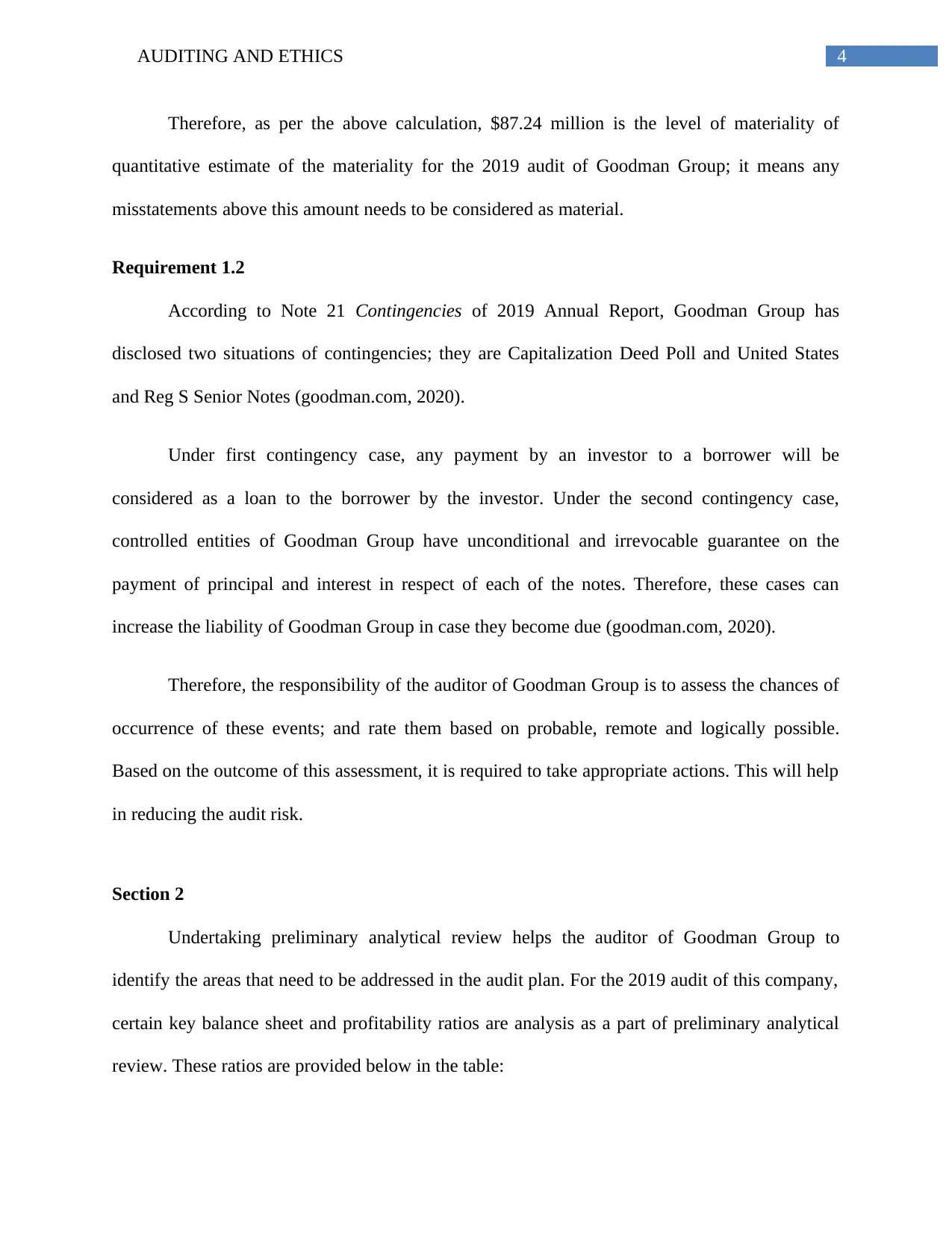
4AUDITING AND ETHICS
Therefore, as per the above calculation, $87.24 million is the level of materiality of
quantitative estimate of the materiality for the 2019 audit of Goodman Group; it means any
misstatements above this amount needs to be considered as material.
Requirement 1.2
According to Note 21 Contingencies of 2019 Annual Report, Goodman Group has
disclosed two situations of contingencies; they are Capitalization Deed Poll and United States
and Reg S Senior Notes (goodman.com, 2020).
Under first contingency case, any payment by an investor to a borrower will be
considered as a loan to the borrower by the investor. Under the second contingency case,
controlled entities of Goodman Group have unconditional and irrevocable guarantee on the
payment of principal and interest in respect of each of the notes. Therefore, these cases can
increase the liability of Goodman Group in case they become due (goodman.com, 2020).
Therefore, the responsibility of the auditor of Goodman Group is to assess the chances of
occurrence of these events; and rate them based on probable, remote and logically possible.
Based on the outcome of this assessment, it is required to take appropriate actions. This will help
in reducing the audit risk.
Section 2
Undertaking preliminary analytical review helps the auditor of Goodman Group to
identify the areas that need to be addressed in the audit plan. For the 2019 audit of this company,
certain key balance sheet and profitability ratios are analysis as a part of preliminary analytical
review. These ratios are provided below in the table:
Therefore, as per the above calculation, $87.24 million is the level of materiality of
quantitative estimate of the materiality for the 2019 audit of Goodman Group; it means any
misstatements above this amount needs to be considered as material.
Requirement 1.2
According to Note 21 Contingencies of 2019 Annual Report, Goodman Group has
disclosed two situations of contingencies; they are Capitalization Deed Poll and United States
and Reg S Senior Notes (goodman.com, 2020).
Under first contingency case, any payment by an investor to a borrower will be
considered as a loan to the borrower by the investor. Under the second contingency case,
controlled entities of Goodman Group have unconditional and irrevocable guarantee on the
payment of principal and interest in respect of each of the notes. Therefore, these cases can
increase the liability of Goodman Group in case they become due (goodman.com, 2020).
Therefore, the responsibility of the auditor of Goodman Group is to assess the chances of
occurrence of these events; and rate them based on probable, remote and logically possible.
Based on the outcome of this assessment, it is required to take appropriate actions. This will help
in reducing the audit risk.
Section 2
Undertaking preliminary analytical review helps the auditor of Goodman Group to
identify the areas that need to be addressed in the audit plan. For the 2019 audit of this company,
certain key balance sheet and profitability ratios are analysis as a part of preliminary analytical
review. These ratios are provided below in the table:
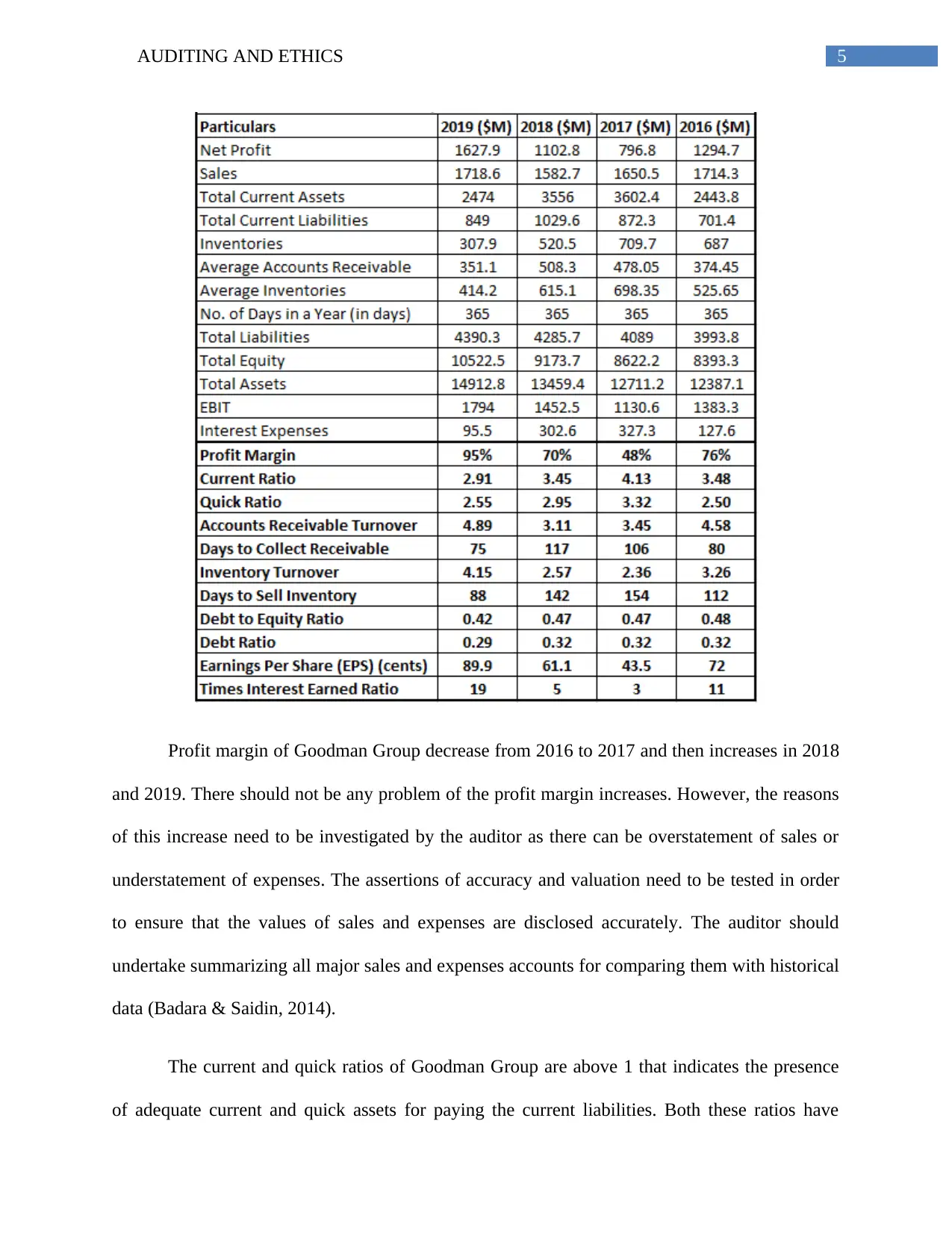
5AUDITING AND ETHICS
Profit margin of Goodman Group decrease from 2016 to 2017 and then increases in 2018
and 2019. There should not be any problem of the profit margin increases. However, the reasons
of this increase need to be investigated by the auditor as there can be overstatement of sales or
understatement of expenses. The assertions of accuracy and valuation need to be tested in order
to ensure that the values of sales and expenses are disclosed accurately. The auditor should
undertake summarizing all major sales and expenses accounts for comparing them with historical
data (Badara & Saidin, 2014).
The current and quick ratios of Goodman Group are above 1 that indicates the presence
of adequate current and quick assets for paying the current liabilities. Both these ratios have
Profit margin of Goodman Group decrease from 2016 to 2017 and then increases in 2018
and 2019. There should not be any problem of the profit margin increases. However, the reasons
of this increase need to be investigated by the auditor as there can be overstatement of sales or
understatement of expenses. The assertions of accuracy and valuation need to be tested in order
to ensure that the values of sales and expenses are disclosed accurately. The auditor should
undertake summarizing all major sales and expenses accounts for comparing them with historical
data (Badara & Saidin, 2014).
The current and quick ratios of Goodman Group are above 1 that indicates the presence
of adequate current and quick assets for paying the current liabilities. Both these ratios have
⊘ This is a preview!⊘
Do you want full access?
Subscribe today to unlock all pages.

Trusted by 1+ million students worldwide
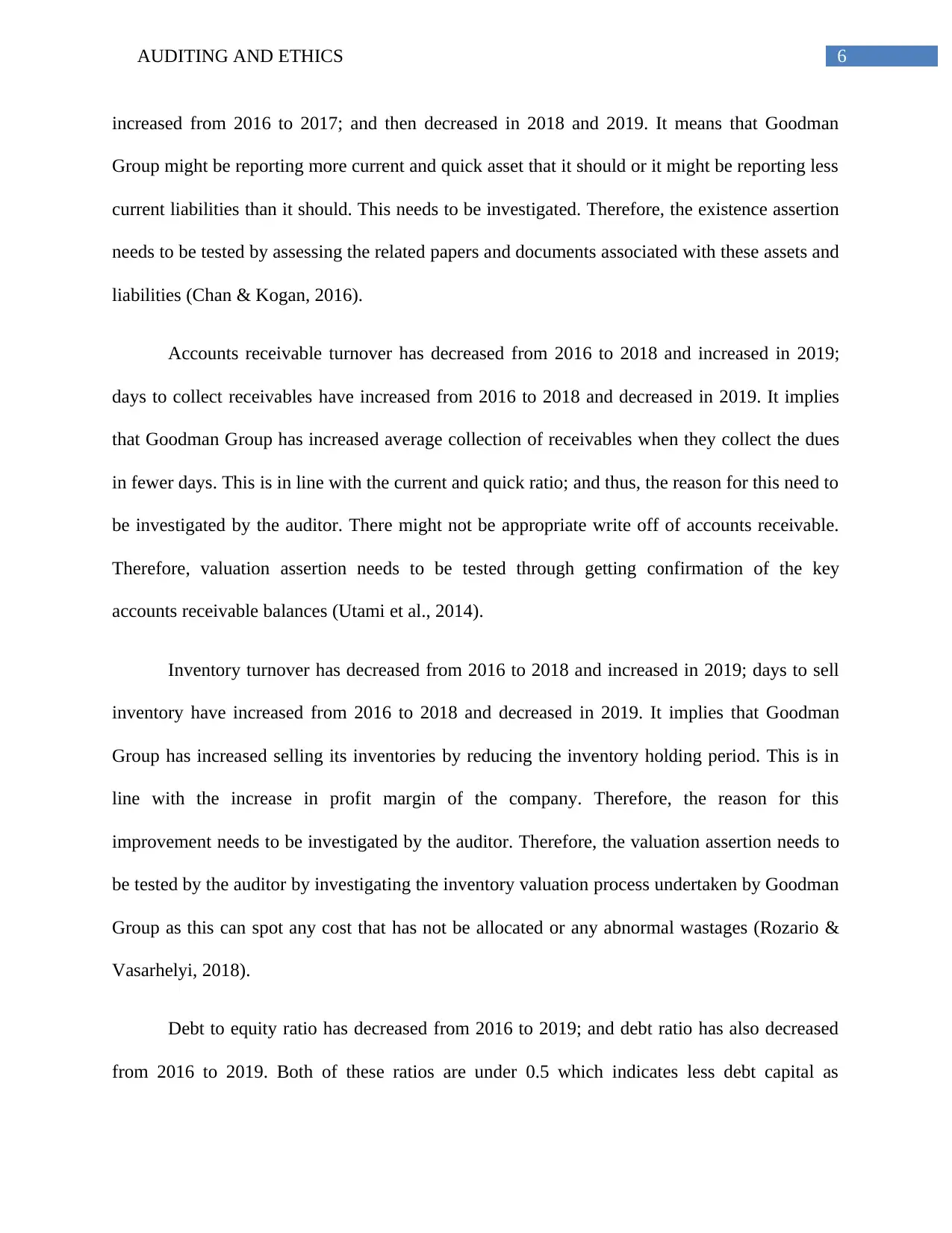
6AUDITING AND ETHICS
increased from 2016 to 2017; and then decreased in 2018 and 2019. It means that Goodman
Group might be reporting more current and quick asset that it should or it might be reporting less
current liabilities than it should. This needs to be investigated. Therefore, the existence assertion
needs to be tested by assessing the related papers and documents associated with these assets and
liabilities (Chan & Kogan, 2016).
Accounts receivable turnover has decreased from 2016 to 2018 and increased in 2019;
days to collect receivables have increased from 2016 to 2018 and decreased in 2019. It implies
that Goodman Group has increased average collection of receivables when they collect the dues
in fewer days. This is in line with the current and quick ratio; and thus, the reason for this need to
be investigated by the auditor. There might not be appropriate write off of accounts receivable.
Therefore, valuation assertion needs to be tested through getting confirmation of the key
accounts receivable balances (Utami et al., 2014).
Inventory turnover has decreased from 2016 to 2018 and increased in 2019; days to sell
inventory have increased from 2016 to 2018 and decreased in 2019. It implies that Goodman
Group has increased selling its inventories by reducing the inventory holding period. This is in
line with the increase in profit margin of the company. Therefore, the reason for this
improvement needs to be investigated by the auditor. Therefore, the valuation assertion needs to
be tested by the auditor by investigating the inventory valuation process undertaken by Goodman
Group as this can spot any cost that has not be allocated or any abnormal wastages (Rozario &
Vasarhelyi, 2018).
Debt to equity ratio has decreased from 2016 to 2019; and debt ratio has also decreased
from 2016 to 2019. Both of these ratios are under 0.5 which indicates less debt capital as
increased from 2016 to 2017; and then decreased in 2018 and 2019. It means that Goodman
Group might be reporting more current and quick asset that it should or it might be reporting less
current liabilities than it should. This needs to be investigated. Therefore, the existence assertion
needs to be tested by assessing the related papers and documents associated with these assets and
liabilities (Chan & Kogan, 2016).
Accounts receivable turnover has decreased from 2016 to 2018 and increased in 2019;
days to collect receivables have increased from 2016 to 2018 and decreased in 2019. It implies
that Goodman Group has increased average collection of receivables when they collect the dues
in fewer days. This is in line with the current and quick ratio; and thus, the reason for this need to
be investigated by the auditor. There might not be appropriate write off of accounts receivable.
Therefore, valuation assertion needs to be tested through getting confirmation of the key
accounts receivable balances (Utami et al., 2014).
Inventory turnover has decreased from 2016 to 2018 and increased in 2019; days to sell
inventory have increased from 2016 to 2018 and decreased in 2019. It implies that Goodman
Group has increased selling its inventories by reducing the inventory holding period. This is in
line with the increase in profit margin of the company. Therefore, the reason for this
improvement needs to be investigated by the auditor. Therefore, the valuation assertion needs to
be tested by the auditor by investigating the inventory valuation process undertaken by Goodman
Group as this can spot any cost that has not be allocated or any abnormal wastages (Rozario &
Vasarhelyi, 2018).
Debt to equity ratio has decreased from 2016 to 2019; and debt ratio has also decreased
from 2016 to 2019. Both of these ratios are under 0.5 which indicates less debt capital as
Paraphrase This Document
Need a fresh take? Get an instant paraphrase of this document with our AI Paraphraser
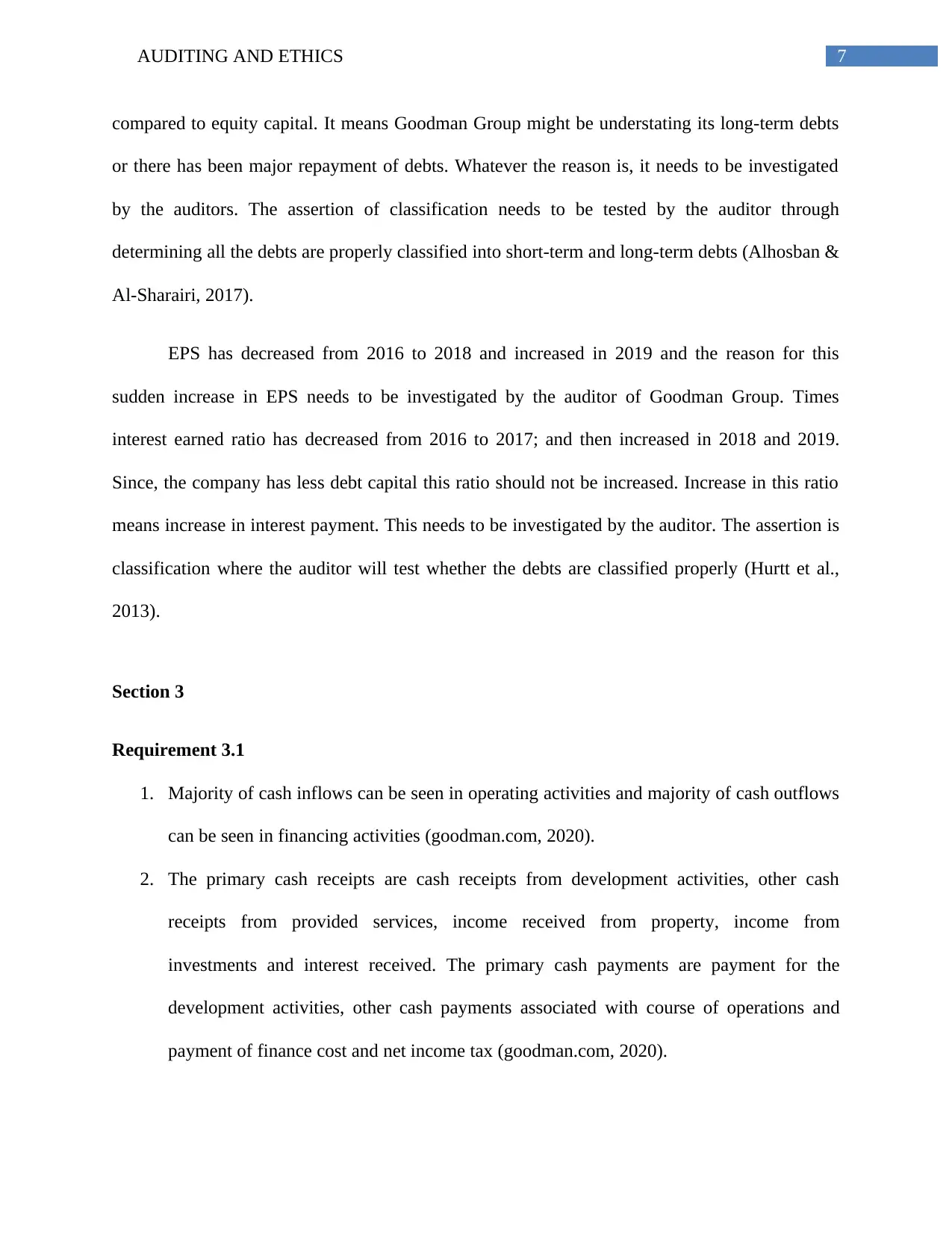
7AUDITING AND ETHICS
compared to equity capital. It means Goodman Group might be understating its long-term debts
or there has been major repayment of debts. Whatever the reason is, it needs to be investigated
by the auditors. The assertion of classification needs to be tested by the auditor through
determining all the debts are properly classified into short-term and long-term debts (Alhosban &
Al-Sharairi, 2017).
EPS has decreased from 2016 to 2018 and increased in 2019 and the reason for this
sudden increase in EPS needs to be investigated by the auditor of Goodman Group. Times
interest earned ratio has decreased from 2016 to 2017; and then increased in 2018 and 2019.
Since, the company has less debt capital this ratio should not be increased. Increase in this ratio
means increase in interest payment. This needs to be investigated by the auditor. The assertion is
classification where the auditor will test whether the debts are classified properly (Hurtt et al.,
2013).
Section 3
Requirement 3.1
1. Majority of cash inflows can be seen in operating activities and majority of cash outflows
can be seen in financing activities (goodman.com, 2020).
2. The primary cash receipts are cash receipts from development activities, other cash
receipts from provided services, income received from property, income from
investments and interest received. The primary cash payments are payment for the
development activities, other cash payments associated with course of operations and
payment of finance cost and net income tax (goodman.com, 2020).
compared to equity capital. It means Goodman Group might be understating its long-term debts
or there has been major repayment of debts. Whatever the reason is, it needs to be investigated
by the auditors. The assertion of classification needs to be tested by the auditor through
determining all the debts are properly classified into short-term and long-term debts (Alhosban &
Al-Sharairi, 2017).
EPS has decreased from 2016 to 2018 and increased in 2019 and the reason for this
sudden increase in EPS needs to be investigated by the auditor of Goodman Group. Times
interest earned ratio has decreased from 2016 to 2017; and then increased in 2018 and 2019.
Since, the company has less debt capital this ratio should not be increased. Increase in this ratio
means increase in interest payment. This needs to be investigated by the auditor. The assertion is
classification where the auditor will test whether the debts are classified properly (Hurtt et al.,
2013).
Section 3
Requirement 3.1
1. Majority of cash inflows can be seen in operating activities and majority of cash outflows
can be seen in financing activities (goodman.com, 2020).
2. The primary cash receipts are cash receipts from development activities, other cash
receipts from provided services, income received from property, income from
investments and interest received. The primary cash payments are payment for the
development activities, other cash payments associated with course of operations and
payment of finance cost and net income tax (goodman.com, 2020).
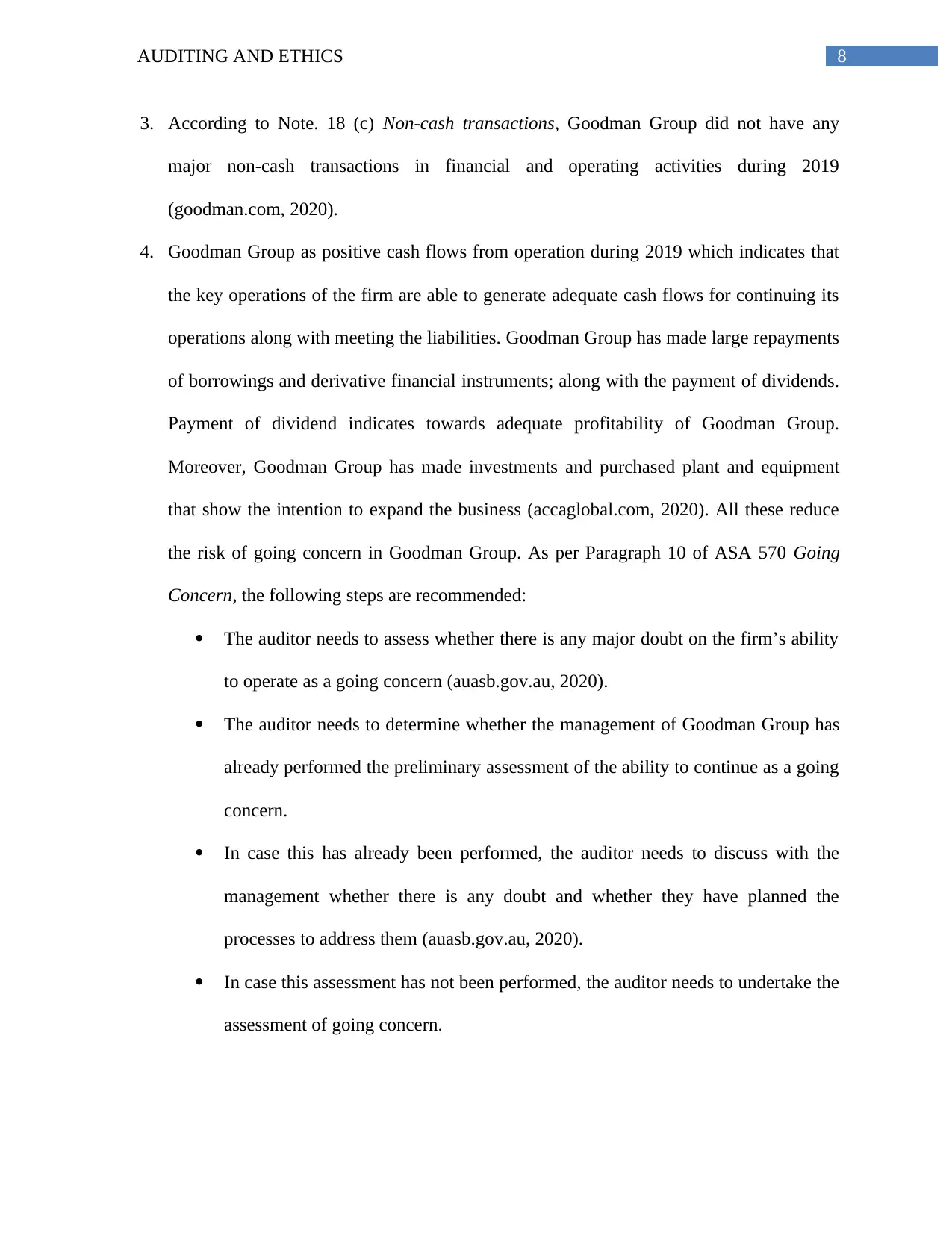
8AUDITING AND ETHICS
3. According to Note. 18 (c) Non-cash transactions, Goodman Group did not have any
major non-cash transactions in financial and operating activities during 2019
(goodman.com, 2020).
4. Goodman Group as positive cash flows from operation during 2019 which indicates that
the key operations of the firm are able to generate adequate cash flows for continuing its
operations along with meeting the liabilities. Goodman Group has made large repayments
of borrowings and derivative financial instruments; along with the payment of dividends.
Payment of dividend indicates towards adequate profitability of Goodman Group.
Moreover, Goodman Group has made investments and purchased plant and equipment
that show the intention to expand the business (accaglobal.com, 2020). All these reduce
the risk of going concern in Goodman Group. As per Paragraph 10 of ASA 570 Going
Concern, the following steps are recommended:
The auditor needs to assess whether there is any major doubt on the firm’s ability
to operate as a going concern (auasb.gov.au, 2020).
The auditor needs to determine whether the management of Goodman Group has
already performed the preliminary assessment of the ability to continue as a going
concern.
In case this has already been performed, the auditor needs to discuss with the
management whether there is any doubt and whether they have planned the
processes to address them (auasb.gov.au, 2020).
In case this assessment has not been performed, the auditor needs to undertake the
assessment of going concern.
3. According to Note. 18 (c) Non-cash transactions, Goodman Group did not have any
major non-cash transactions in financial and operating activities during 2019
(goodman.com, 2020).
4. Goodman Group as positive cash flows from operation during 2019 which indicates that
the key operations of the firm are able to generate adequate cash flows for continuing its
operations along with meeting the liabilities. Goodman Group has made large repayments
of borrowings and derivative financial instruments; along with the payment of dividends.
Payment of dividend indicates towards adequate profitability of Goodman Group.
Moreover, Goodman Group has made investments and purchased plant and equipment
that show the intention to expand the business (accaglobal.com, 2020). All these reduce
the risk of going concern in Goodman Group. As per Paragraph 10 of ASA 570 Going
Concern, the following steps are recommended:
The auditor needs to assess whether there is any major doubt on the firm’s ability
to operate as a going concern (auasb.gov.au, 2020).
The auditor needs to determine whether the management of Goodman Group has
already performed the preliminary assessment of the ability to continue as a going
concern.
In case this has already been performed, the auditor needs to discuss with the
management whether there is any doubt and whether they have planned the
processes to address them (auasb.gov.au, 2020).
In case this assessment has not been performed, the auditor needs to undertake the
assessment of going concern.
⊘ This is a preview!⊘
Do you want full access?
Subscribe today to unlock all pages.

Trusted by 1+ million students worldwide
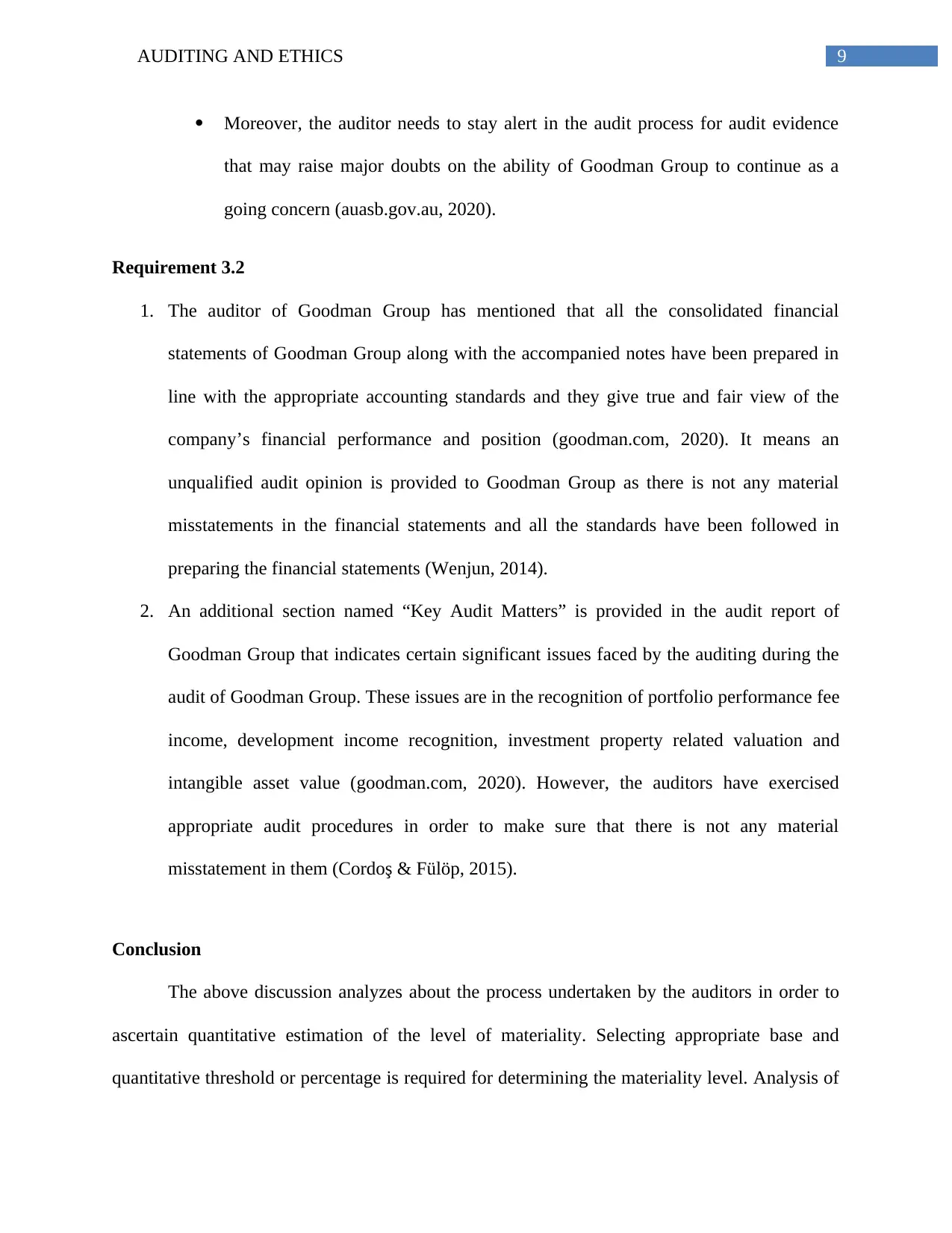
9AUDITING AND ETHICS
Moreover, the auditor needs to stay alert in the audit process for audit evidence
that may raise major doubts on the ability of Goodman Group to continue as a
going concern (auasb.gov.au, 2020).
Requirement 3.2
1. The auditor of Goodman Group has mentioned that all the consolidated financial
statements of Goodman Group along with the accompanied notes have been prepared in
line with the appropriate accounting standards and they give true and fair view of the
company’s financial performance and position (goodman.com, 2020). It means an
unqualified audit opinion is provided to Goodman Group as there is not any material
misstatements in the financial statements and all the standards have been followed in
preparing the financial statements (Wenjun, 2014).
2. An additional section named “Key Audit Matters” is provided in the audit report of
Goodman Group that indicates certain significant issues faced by the auditing during the
audit of Goodman Group. These issues are in the recognition of portfolio performance fee
income, development income recognition, investment property related valuation and
intangible asset value (goodman.com, 2020). However, the auditors have exercised
appropriate audit procedures in order to make sure that there is not any material
misstatement in them (Cordoş & Fülöp, 2015).
Conclusion
The above discussion analyzes about the process undertaken by the auditors in order to
ascertain quantitative estimation of the level of materiality. Selecting appropriate base and
quantitative threshold or percentage is required for determining the materiality level. Analysis of
Moreover, the auditor needs to stay alert in the audit process for audit evidence
that may raise major doubts on the ability of Goodman Group to continue as a
going concern (auasb.gov.au, 2020).
Requirement 3.2
1. The auditor of Goodman Group has mentioned that all the consolidated financial
statements of Goodman Group along with the accompanied notes have been prepared in
line with the appropriate accounting standards and they give true and fair view of the
company’s financial performance and position (goodman.com, 2020). It means an
unqualified audit opinion is provided to Goodman Group as there is not any material
misstatements in the financial statements and all the standards have been followed in
preparing the financial statements (Wenjun, 2014).
2. An additional section named “Key Audit Matters” is provided in the audit report of
Goodman Group that indicates certain significant issues faced by the auditing during the
audit of Goodman Group. These issues are in the recognition of portfolio performance fee
income, development income recognition, investment property related valuation and
intangible asset value (goodman.com, 2020). However, the auditors have exercised
appropriate audit procedures in order to make sure that there is not any material
misstatement in them (Cordoş & Fülöp, 2015).
Conclusion
The above discussion analyzes about the process undertaken by the auditors in order to
ascertain quantitative estimation of the level of materiality. Selecting appropriate base and
quantitative threshold or percentage is required for determining the materiality level. Analysis of
Paraphrase This Document
Need a fresh take? Get an instant paraphrase of this document with our AI Paraphraser
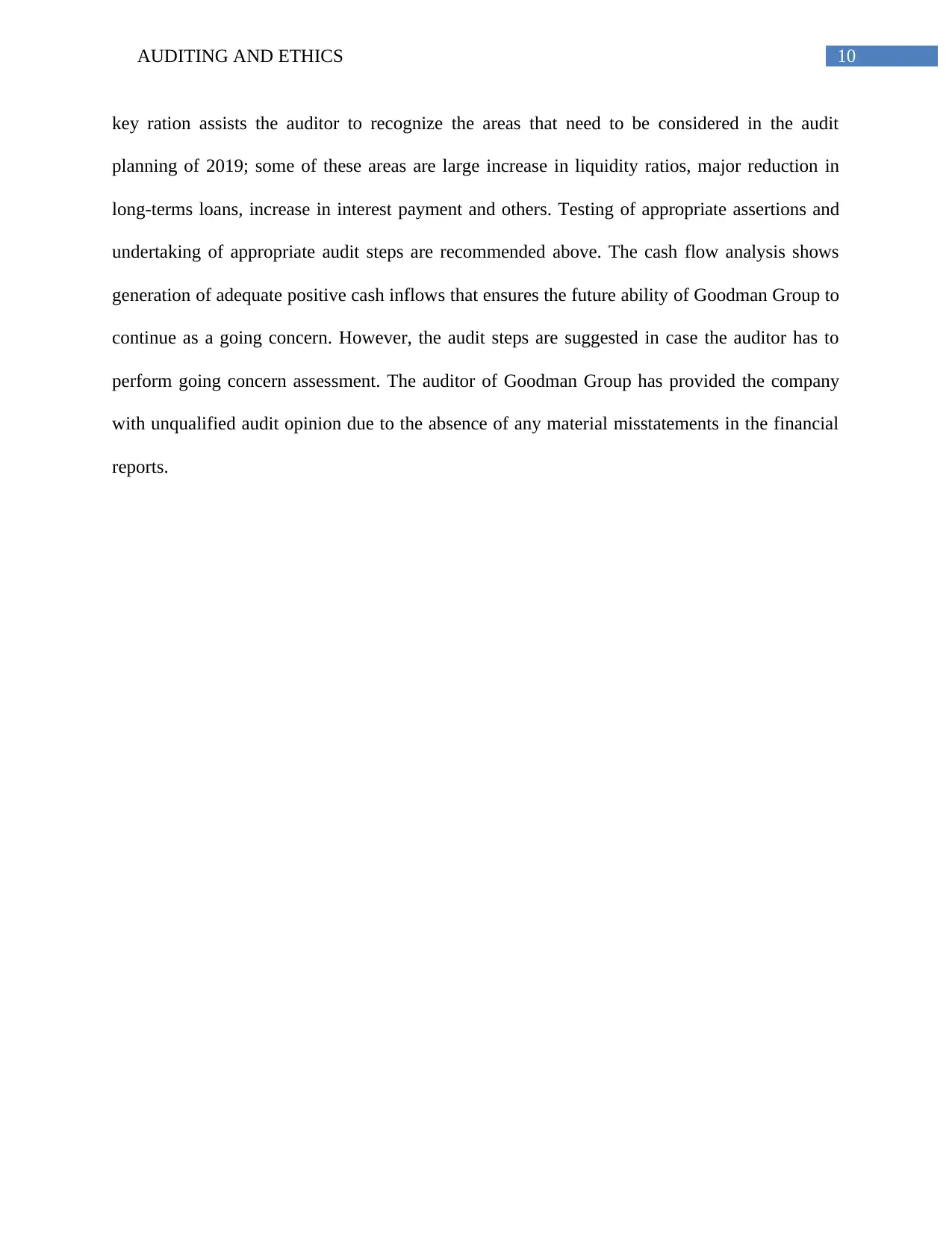
10AUDITING AND ETHICS
key ration assists the auditor to recognize the areas that need to be considered in the audit
planning of 2019; some of these areas are large increase in liquidity ratios, major reduction in
long-terms loans, increase in interest payment and others. Testing of appropriate assertions and
undertaking of appropriate audit steps are recommended above. The cash flow analysis shows
generation of adequate positive cash inflows that ensures the future ability of Goodman Group to
continue as a going concern. However, the audit steps are suggested in case the auditor has to
perform going concern assessment. The auditor of Goodman Group has provided the company
with unqualified audit opinion due to the absence of any material misstatements in the financial
reports.
key ration assists the auditor to recognize the areas that need to be considered in the audit
planning of 2019; some of these areas are large increase in liquidity ratios, major reduction in
long-terms loans, increase in interest payment and others. Testing of appropriate assertions and
undertaking of appropriate audit steps are recommended above. The cash flow analysis shows
generation of adequate positive cash inflows that ensures the future ability of Goodman Group to
continue as a going concern. However, the audit steps are suggested in case the auditor has to
perform going concern assessment. The auditor of Goodman Group has provided the company
with unqualified audit opinion due to the absence of any material misstatements in the financial
reports.
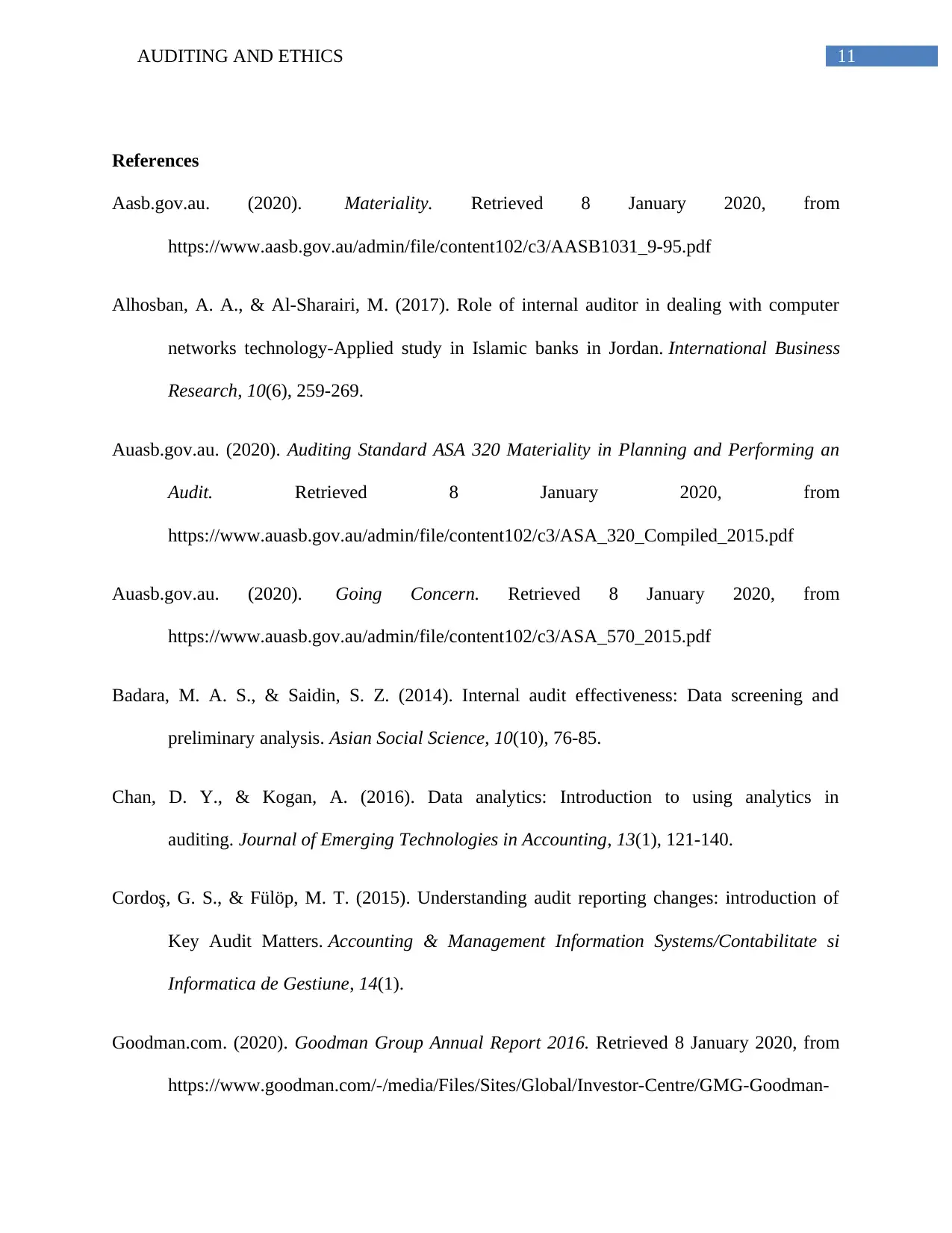
11AUDITING AND ETHICS
References
Aasb.gov.au. (2020). Materiality. Retrieved 8 January 2020, from
https://www.aasb.gov.au/admin/file/content102/c3/AASB1031_9-95.pdf
Alhosban, A. A., & Al-Sharairi, M. (2017). Role of internal auditor in dealing with computer
networks technology-Applied study in Islamic banks in Jordan. International Business
Research, 10(6), 259-269.
Auasb.gov.au. (2020). Auditing Standard ASA 320 Materiality in Planning and Performing an
Audit. Retrieved 8 January 2020, from
https://www.auasb.gov.au/admin/file/content102/c3/ASA_320_Compiled_2015.pdf
Auasb.gov.au. (2020). Going Concern. Retrieved 8 January 2020, from
https://www.auasb.gov.au/admin/file/content102/c3/ASA_570_2015.pdf
Badara, M. A. S., & Saidin, S. Z. (2014). Internal audit effectiveness: Data screening and
preliminary analysis. Asian Social Science, 10(10), 76-85.
Chan, D. Y., & Kogan, A. (2016). Data analytics: Introduction to using analytics in
auditing. Journal of Emerging Technologies in Accounting, 13(1), 121-140.
Cordoş, G. S., & Fülöp, M. T. (2015). Understanding audit reporting changes: introduction of
Key Audit Matters. Accounting & Management Information Systems/Contabilitate si
Informatica de Gestiune, 14(1).
Goodman.com. (2020). Goodman Group Annual Report 2016. Retrieved 8 January 2020, from
https://www.goodman.com/-/media/Files/Sites/Global/Investor-Centre/GMG-Goodman-
References
Aasb.gov.au. (2020). Materiality. Retrieved 8 January 2020, from
https://www.aasb.gov.au/admin/file/content102/c3/AASB1031_9-95.pdf
Alhosban, A. A., & Al-Sharairi, M. (2017). Role of internal auditor in dealing with computer
networks technology-Applied study in Islamic banks in Jordan. International Business
Research, 10(6), 259-269.
Auasb.gov.au. (2020). Auditing Standard ASA 320 Materiality in Planning and Performing an
Audit. Retrieved 8 January 2020, from
https://www.auasb.gov.au/admin/file/content102/c3/ASA_320_Compiled_2015.pdf
Auasb.gov.au. (2020). Going Concern. Retrieved 8 January 2020, from
https://www.auasb.gov.au/admin/file/content102/c3/ASA_570_2015.pdf
Badara, M. A. S., & Saidin, S. Z. (2014). Internal audit effectiveness: Data screening and
preliminary analysis. Asian Social Science, 10(10), 76-85.
Chan, D. Y., & Kogan, A. (2016). Data analytics: Introduction to using analytics in
auditing. Journal of Emerging Technologies in Accounting, 13(1), 121-140.
Cordoş, G. S., & Fülöp, M. T. (2015). Understanding audit reporting changes: introduction of
Key Audit Matters. Accounting & Management Information Systems/Contabilitate si
Informatica de Gestiune, 14(1).
Goodman.com. (2020). Goodman Group Annual Report 2016. Retrieved 8 January 2020, from
https://www.goodman.com/-/media/Files/Sites/Global/Investor-Centre/GMG-Goodman-
⊘ This is a preview!⊘
Do you want full access?
Subscribe today to unlock all pages.

Trusted by 1+ million students worldwide
1 out of 14
Related Documents
Your All-in-One AI-Powered Toolkit for Academic Success.
+13062052269
info@desklib.com
Available 24*7 on WhatsApp / Email
![[object Object]](/_next/static/media/star-bottom.7253800d.svg)
Unlock your academic potential
Copyright © 2020–2025 A2Z Services. All Rights Reserved. Developed and managed by ZUCOL.





